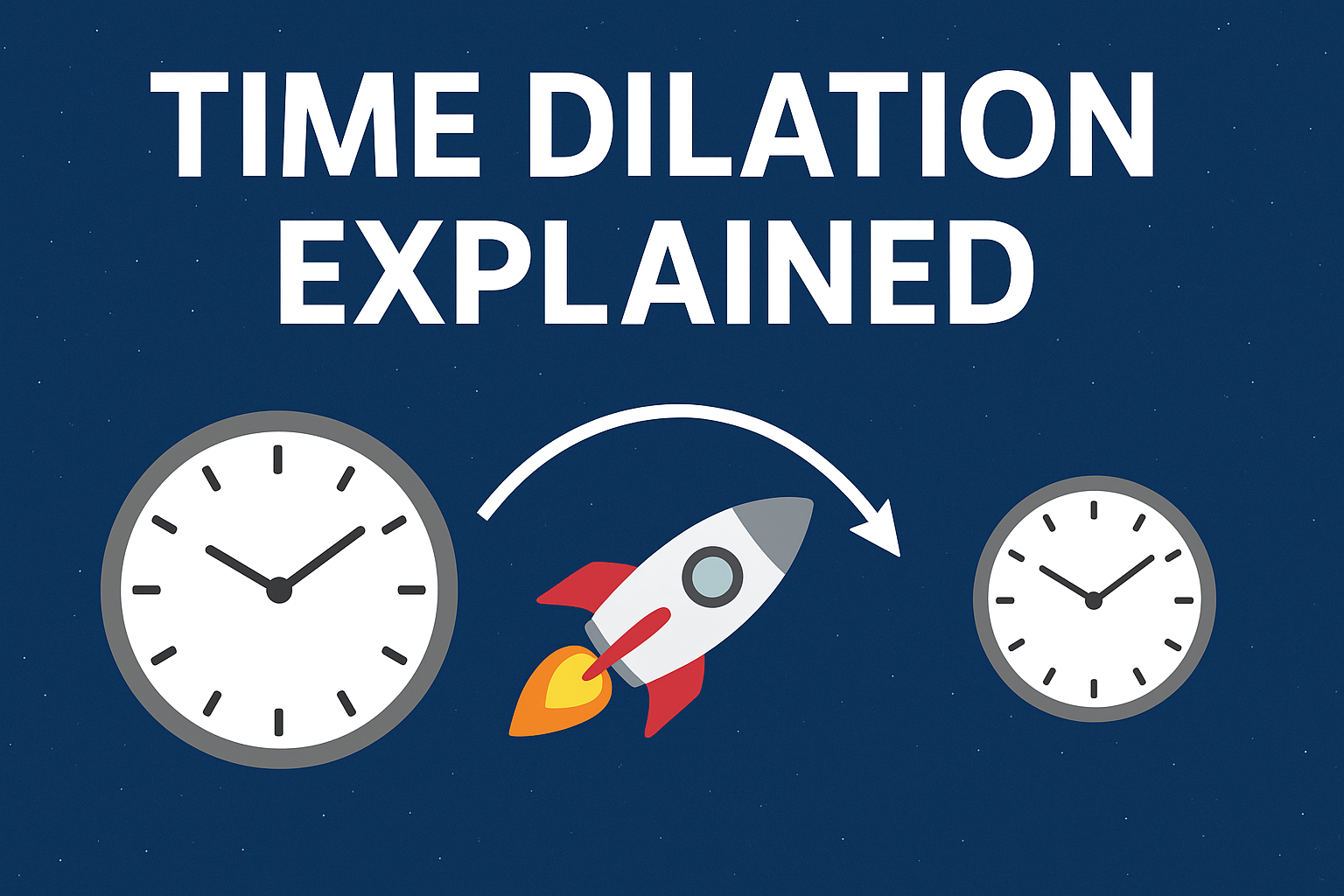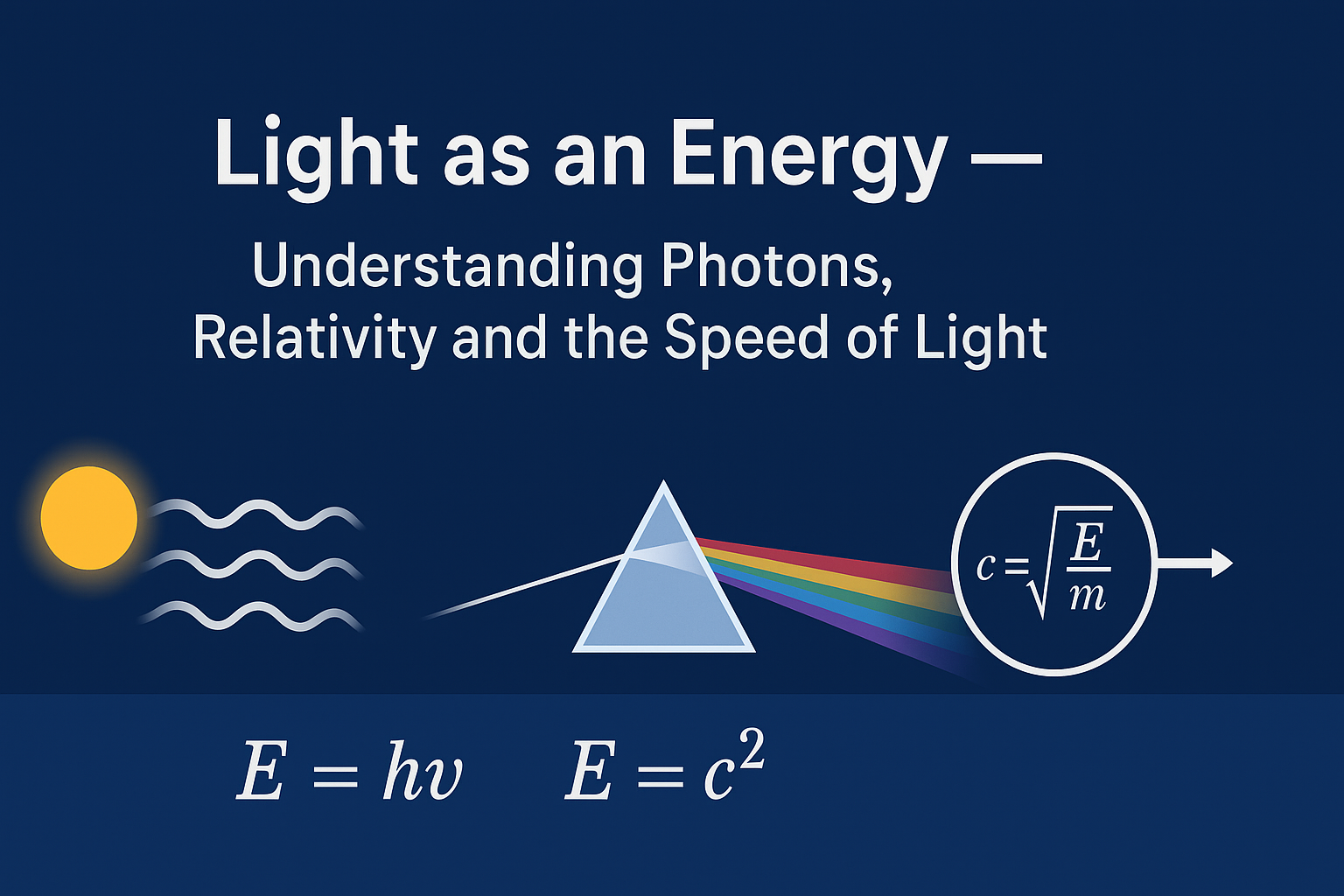Time dilation is one of the most fascinating concepts in physics. It shows that time is not constant, not absolute, and not the same for everyone. Time can slow down depending on speed, gravity, or the observer’s frame of reference. This article explains the complete theory of time dilation using simple language, detailed explanations, real-life examples, and mathematical derivations using Einstein’s relativity.
Introduction
When we hear the word time, we assume it is universal. One second for you is one second for everyone. But modern physics proved this wrong. Time is flexible. It stretches and compresses depending on the motion and gravitational field.
This idea is known as Time Dilation, a key prediction of both Special Relativity (1905) and General Relativity (1915), proposed by Albert Einstein.
According to Einstein, the faster you move, the slower time passes for you. Similarly, the stronger the gravity around you, the slower time moves. This means time is not absolute — it is relative to the observer and their environment.
Historical Background
Before Einstein, scientists believed in the Newtonian idea of absolute time. According to Newton, time flows at the same speed everywhere in the universe. It never changes and never depends on motion or gravity.
But several experiments started showing contradictions:
- Michelson–Morley Experiment (1887) could not detect the motion of Earth through luminiferous ether.
- Maxwell’s equations predicted constant speed of light, which conflicted with Newtonian mechanics.
- Observation of fast-moving particles showed that they live longer than expected.
These anomalies made physicists realize that the existing understanding of time and space was incomplete.
Einstein’s Breakthrough
In 1905, in his paper “On the Electrodynamics of Moving Bodies,” Einstein proposed the Special Theory of Relativity. The theory was built on two revolutionary postulates:
- The laws of physics are the same in all inertial reference frames.
- The speed of light in a vacuum (c = 3 × 108 m/s) is constant for all observers.
These two statements completely changed how we understand space and time. From them, Einstein derived the concept of time dilation.
What is Time Dilation?
Time dilation means that time does not pass equally for everyone. If two people move at different speeds or are in different gravitational fields, they will experience time differently.
Example: If an astronaut travels at 80% of the speed of light, time for him will be slower than for people on Earth. When he returns, he will be younger than his twin brother. This is called the Twin Paradox.
Types of Time Dilation
- 1. Special Relativity Time Dilation – Due to speed (relative motion)
- 2. General Relativity Time Dilation – Due to gravity (curved spacetime)
Special Relativity: Time Dilation Due to Speed
According to Special Relativity, time slows down for an object when it moves close to the speed of light. This is represented by the famous equation:
$$ t' = \frac{t}{\sqrt{1 - \frac{v^2}{c^2}}} $$
Meaning of the Terms
- t' = dilated time (time experienced by the moving observer)
- t = proper time (time measured by stationary observer)
- v = speed of moving object
- c = speed of light (constant)
The denominator \( \sqrt{1 - v^2/c^2} \) is called the Lorentz Factor.
$$ \gamma = \frac{1}{\sqrt{1 - \frac{v^2}{c^2}}} $$
So the time dilation equation becomes:
$$ t' = \gamma t $$
Step-by-Step Example
Problem: A spaceship moves at 0.8c. If 10 years pass on Earth, how much time passes inside the spaceship?
Step 1: Find Lorentz Factor
$$ \gamma = \frac{1}{\sqrt{1 - (0.8)^2}} $$
$$ = \frac{1}{\sqrt{1 - 0.64}} $$
$$ = \frac{1}{\sqrt{0.36}} $$
$$ = \frac{1}{0.6} = 1.666 $$
Step 2: Apply Time Dilation Formula
$$ t' = \frac{10}{1.666} \approx 6 \text{ years} $$
So only 6 years pass for the astronaut, while 10 years pass on Earth.
Mass Increase at High Speeds
Einstein also discovered that as speed increases, an object’s relativistic mass increases. This is related to his energy–mass relation:
$$ E = mc^2 $$
At high speeds, mass becomes:
$$ m = \gamma m_0 $$
- m = relativistic mass
- m₀ = rest mass
- γ = Lorentz factor
This means that as velocity increases, the mass increases due to increased energy. And because more energy is required to accelerate an object close to light speed, no object with mass can reach or exceed the speed of light.
General Relativity: Time Dilation Due to Gravity
While Special Relativity explains how time slows due to motion, General Relativity explains how time slows due to gravity. Einstein showed that gravity is not a force, but the curvature of spacetime. Massive objects like planets, stars, and black holes bend space and time around them.
The stronger the gravitational field, the slower time passes. This is known as Gravitational Time Dilation.
This effect has been experimentally confirmed through clocks placed on mountains, satellites, and near massive bodies.
What is Spacetime?
Traditional physics viewed space and time as separate. Einstein unified them into a single four-dimensional continuum called spacetime.
Mass curves spacetime, and objects move according to this curvature. Even light bends due to this curvature, not because gravity “pulls” it.
Because spacetime is curved, clocks at different altitudes experience time at different rates.
Equation for Gravitational Time Dilation
General Relativity gives an approximate formula for gravitational time dilation near a spherical mass like Earth.
$$ t' = t \\, \sqrt{1 - \frac{2GM}{rc^2}} $$
Meaning of the terms
- t' = time in stronger gravity (slower time)
- t = time in weaker gravity (faster time)
- G = gravitational constant
- M = mass of the planet or body
- r = radial distance from the center
- c = speed of light
If r decreases (meaning you are closer to the mass), the term inside the square root becomes smaller, and therefore time slows down.
This is why clocks on mountains tick slightly faster than clocks at sea level—because mountains are farther from Earth’s center.
Step-by-Step Example: Time Difference at Two Heights
Problem: How much difference is there between the time at sea level and the time at 5,000 meters above sea level?
Given:
- Earth’s mass: \( M = 5.97 \times 10^{24}\, kg \)
- Radius at sea level: \( R = 6.371 \times 10^6\, m \)
- Height difference: \( h = 5000\, m \)
- Upper radius: \( r = R + h \)
Step 1: Compute radius values
$$ r = 6.371 \times 10^6 + 5000 = 6.376 \times 10^6 \, m $$
Step 2: Apply the gravitational time dilation equation
$$ t_{sea} = t \sqrt{1 - \frac{2GM}{R c^2}} $$
$$ t_{mountain} = t \sqrt{1 - \frac{2GM}{r c^2}} $$
Step 3: Compare the two results
Since \( r > R \), the term $$ \sqrt{1 - \frac{2GM}{r c^2}} $$ is slightly larger.
Meaning: Clocks at higher altitudes tick faster than clocks at sea level.
The actual difference is extremely small, only a few nanoseconds per day, but detectable using atomic clocks.
Real-Life Application: GPS and Time Dilation
The Global Positioning System (GPS) serves as one of the best proofs of time dilation in real life. GPS satellites orbit Earth at about 20,000 km above the surface and travel at very high speeds.
Two Relativistic Effects Occur:
- Special Relativity: Because satellites move fast, their time runs slower compared to Earth clocks.
- General Relativity: Because satellites are far from Earth's surface (weaker gravity), their time runs faster than Earth clocks.
These effects do not cancel out — gravitational effect is stronger.
Daily Time Shift
- Special Relativity: clocks slow down by ≈ 7 microseconds/day
- General Relativity: clocks speed up by ≈ 45 microseconds/day
Net gain in satellite time: 38 microseconds/day faster than Earth clocks.
Without correction:
- GPS positions would be wrong by 10 km per day
- The entire navigation system would fail
The Twin Paradox (Explained Clearly)
The Twin Paradox is the most famous thought experiment demonstrating time dilation. One twin stays on Earth, and the other travels in a spaceship at near-light speed.
When the traveling twin returns, he is younger because:
- He experiences special relativity time dilation
- He changes reference frames while turning around
- His path in spacetime is shorter
There is no contradiction; the acceleration (frame change) breaks the symmetry.
Mathematical View
$$ t' = \frac{t}{\gamma} $$
If the ship travels at 0.9c for 6 years (ship time):
$$ \gamma = \frac{1}{\sqrt{1 - (0.9)^2}} = 2.294 $$
Earth time = $$ 6 \times 2.294 = 13.76 $$ years → Earth twin ages ~14 years → Space twin ages 6 years
Lorentz Transformations: The Mathematical Foundation of Time Dilation
Time dilation is not an isolated concept. It arises naturally from the deeper mathematical structure of Special Relativity known as Lorentz Transformations. These transformations describe how time and space coordinates change between two observers moving relative to each other.
Before Einstein, classical physics used the Galilean transformations, assuming time is absolute. But these transformations fail at high speeds or when dealing with the speed of light.
Einstein corrected this by introducing the Lorentz Transformations, which preserve the constancy of the speed of light.
The Lorentz Transformation Equations
Suppose we have two reference frames:
- Frame S – stationary observer
- Frame S′ – moving observer (speed v in the x-direction)
The Lorentz transformations relate coordinates (x, t) in frame S to (x′, t′) in S′:
$$ x' = \gamma (x - vt) $$
$$ t' = \gamma \left(t - \frac{vx}{c^2}\right) $$
where the Lorentz factor is:
$$ \gamma = \frac{1}{\sqrt{1 - \frac{v^2}{c^2}}} $$
Time dilation emerges naturally from the second equation.
Derivation of Time Dilation from Lorentz Transformations
Step 1: Assume a clock at rest in the moving frame S′.
Since the clock is stationary in S′:
$$ x' = 0 $$
Step 2: Use the first Lorentz equation:
If \( x' = 0 \):
$$ 0 = \gamma(x - vt) $$
⇒ $$ x = vt $$
Step 3: Substitute into the time equation:
$$ t' = \gamma \left(t - \frac{v(vt)}{c^2}\right) $$
Simplify inside the bracket:
$$ t' = \gamma t (1 - \frac{v^2}{c^2}) $$
Step 4: Multiply γ with the bracket:
Since $$ \gamma = \frac{1}{\sqrt{1 - v^2/c^2}} $$
Then:
$$ t' = t \sqrt{1 - \frac{v^2}{c^2}} $$
Or equivalently:
$$ t = \gamma t' $$
This is the standard **time dilation equation**.
Conclusion: The faster you move, the slower your time passes relative to a stationary observer.
Relativistic Velocity Addition
In classical physics, if you walk at 5 km/h inside a train moving at 50 km/h, your speed relative to the ground becomes 55 km/h.
But in relativity, velocities do not add linearly because nothing can exceed the speed of light.
The correct formula is:
$$ u' = \frac{u + v}{1 + \frac{uv}{c^2}} $$
- u = speed of object
- v = speed of reference frame
- u′ = combined velocity
Notice that even if both u and v are near the speed of light, the denominator ensures that the resulting value never exceeds c.
Deep Explanation of Einstein’s Mass–Energy Relation (E = mc²)
One of the most famous equations in physics is:
$$ E = mc^2 $$
This equation states that mass is simply another form of energy. They are interchangeable and convertible.
What Happens at High Speeds?
As an object accelerates close to the speed of light, its kinetic energy increases dramatically. But instead of only increasing speed, the extra energy increases the object’s relativistic mass.
$$ m = \gamma m_0 $$
- m = relativistic mass
- m₀ = rest mass
Because γ increases without limit as v → c, mass also approaches infinity.
This is why:
Nothing with mass can reach or exceed the speed of light.
It would require infinite energy, which is physically impossible.
Why Nothing Can Travel Faster Than Light
There are several reasons why reaching or exceeding light speed is impossible:
- 1. Infinite Energy Requirement: As velocity approaches c, γ → ∞, so the energy required becomes infinite.
- 2. Relativistic Mass Increases: The object becomes heavier and harder to accelerate.
- 3. Time Stops at Light Speed: According to relativity, time would slow to zero if an object traveled at c.
- 4. Causality Violations: Faster-than-light travel could break cause-and-effect, which physics forbids.
Only massless particles like photons can move at light speed.
Experimental Proofs of Time Dilation
Time dilation is not theoretical—it has been confirmed repeatedly in laboratory and cosmic experiments.
1. Muon Lifetime Experiments
Muons are particles created in the upper atmosphere. Their lifetime at rest is too short to reach the Earth’s surface. But because they travel at near-light speeds, their internal clocks slow down. Hence, many muons reach Earth—verified using detectors.
2. Particle Accelerators
In accelerators, particles live much longer than expected. Their lifetimes extend due to time dilation.
3. Atomic Clocks on Airplanes
The Hafele–Keating experiment (1971) flew atomic clocks around Earth in jets. The airborne clocks showed measurable time delays exactly matching relativity predictions.
4. GPS Satellites
As explained earlier, GPS satellites must correct for relativistic time dilation, or navigation accuracy would collapse.
5. Gravity Probe A
A 1976 experiment that sent a hydrogen maser clock into space and measured gravitational time dilation with extreme precision. The results matched General Relativity.
Gravitational Time Dilation: Time Slows in Strong Gravity
Until now, we have explored time dilation caused by motion, which comes from Albert Einstein’s theory of Special Relativity. However, Einstein's work did not stop there. He further discovered that gravity also affects time. According to the theory of General Relativity, time runs slower near a massive object—such as a planet, star, or black hole—compared to a weaker gravitational region. This effect is known as gravitational time dilation.
In simple words:
Stronger gravity = Slower time
Weaker gravity = Faster time
This idea completely changed how scientists understand space, time, and the universe. It also explained why Newton’s gravity model was incomplete. General Relativity shows that gravity is not a force but the curvature of spacetime.
4.1 Why Does Gravity Slow Time?
Einstein proposed that massive objects distort the fabric of spacetime. Imagine a heavy ball placed on a stretched rubber sheet — it creates a depression. Similarly, Earth creates a curvature in spacetime. Clocks located deeper in this curvature (closer to Earth) run slower compared to clocks farther away.
Therefore:
A clock at sea level runs slower than a clock on top of a mountain.
4.2 Mathematical Formula for Gravitational Time Dilation
The gravitational time dilation formula is derived from the Schwarzschild metric:
$$ \Delta t' = \Delta t \sqrt{1 - \frac{2GM}{rc^2}} $$
Where:
- Δt' = time experienced near the massive body
- Δt = time experienced far away from massive body
- G = gravitational constant
- M = mass of the body (Earth, Sun, etc.)
- r = distance from the center of the mass
- c = speed of light
Notice that the expression inside the square root is always less than 1. Therefore, the gravitationally affected time Δt' is always smaller than Δt — meaning time runs slower in strong gravity.
4.3 Step-by-Step Explanation of Equation
Step 1: Compute the term inside fraction:
$$ \frac{2GM}{r c^2} $$
Step 2: Subtract this value from 1:
$$ 1 - \frac{2GM}{rc^2} $$
Step 3: Take the square root:
$$ \sqrt{1 - \frac{2GM}{rc^2}} $$
Step 4: Multiply the result with Δt.
4.4 Worked Example: Clock on Earth vs Clock in Space
Let’s compare time at the Earth’s surface and time far away from Earth.
Given:
- Earth mass: \( M = 5.97 \times 10^{24} \, kg \)
- Earth radius: \( r = 6.371 \times 10^{6} \, m \)
- Gravitational constant: \( G = 6.674 \times 10^{-11} \)
- Speed of light: \( c = 3 \times 10^8 \)
Step 1:
$$ \frac{2GM}{rc^2} = \frac{2(6.674 \times 10^{-11})(5.97 \times 10^{24})}{(6.371 \times 10^6)(9 \times 10^{16})} $$
Approximate result:
$$ \frac{2GM}{rc^2} \approx 1.39 \times 10^{-9} $$
Step 2:
$$ 1 - 1.39 \times 10^{-9} \approx 0.99999999861 $$
Step 3:
$$ \sqrt{0.99999999861} \approx 0.99999999930 $$
Interpretation: A clock on Earth runs slightly slower than a clock in space. If an astronaut spends years in orbit, they actually age a tiny bit faster than people on Earth.
4.5 Real-Life Proof: GPS Satellites
GPS satellites orbit Earth at about 20,000 km above the surface. They experience both:
- Less gravity → faster time
- High speed → slower time
General Relativity predicts their clocks tick 45 microseconds faster per day due to gravity. Special Relativity predicts they tick 7 microseconds slower per day due to speed.
Net effect: GPS clocks run 38 microseconds faster per day.
Engineers must correct this difference, otherwise GPS accuracy will drift by kilometers per day. This is one of the strongest proofs that gravitational time dilation is real.
4.6 Black Holes: The Extreme of Time Dilation
Near a black hole, gravity becomes extremely strong. As you approach the event horizon (the boundary beyond which nothing escapes), time slows dramatically. According to GR:
At the event horizon, external time becomes infinitely faster compared to time near it.
To an outside observer, you appear frozen. This concept is essential in astrophysics, study of quasars, and high-energy collisions in the universe.
4.7 Gravity and Mass-Energy Relation
Einstein's famous equation relates mass and energy:
$$ E = mc^2 $$
As an object gains kinetic energy (by moving faster), some of that energy contributes to relativistic mass increase. More mass means a greater influence on gravity. This interconnection between mass, gravity, and time is one of the greatest strengths of General Relativity.
The Twin Paradox and High-Speed Relativity Effects
One of the most famous and most debated relativity examples is the Twin Paradox. It is not actually a paradox, but a situation that clearly demonstrates how time dilation makes one person age slower when traveling at relativistic speeds. This effect has been tested, verified, and accepted by modern physics.
5.1 What Is the Twin Paradox?
Imagine two twins: Aryan and Kabir. Aryan stays on Earth, while Kabir travels in a spaceship at 95% of the speed of light. Because Kabir is moving so fast, his time runs slower compared to Aryan.
When Kabir returns from the journey, Aryan has aged more than him. This result surprises people because many think “each person sees the other moving,” but the key fact is that:
The traveling twin experiences acceleration, turning points, and changing frames of reference.
These changes break the symmetry, making the effect completely real and not a paradox.
5.2 Time Dilation Equation in Twin Paradox
The same Lorentz factor is used:
$$ \Delta t' = \frac{\Delta t}{\gamma} $$
Where \( \Delta t \) is Earth time, and \( \Delta t' \) is the time experienced by the traveler.
The Lorentz factor is:
$$ \gamma = \frac{1}{\sqrt{1 - \frac{v^2}{c^2}}} $$
5.3 Step-by-Step Example: Traveling at 95% Speed of Light
Given:
- Speed: \( v = 0.95c \)
- Earth time for round trip: 20 years
Step 1: Calculate Lorentz factor
$$ \gamma = \frac{1}{\sqrt{1 - (0.95)^2}} $$
$$ = \frac{1}{\sqrt{1 - 0.9025}} = \frac{1}{\sqrt{0.0975}} $$
$$ \gamma \approx 3.202 $$
Step 2: Calculate traveler’s time
$$ \Delta t' = \frac{20}{3.202} \approx 6.24 \text{ years} $$
So Aryan ages 20 years, while Kabir ages only about 6 years. Time dilation is extremely significant at relativistic speeds.
5.4 Why the Twin Paradox Is Not a Paradox
The reason the effects are not symmetrical is:
- The traveling twin changes reference frames during acceleration.
- Earth twin remains in an inertial frame.
- Relativity only applies symmetry for inertial frames, not accelerating ones.
Thus, General Relativity and Special Relativity together remove all confusion.
5.5 Real-Life Experiments Proving Time Dilation
Time dilation is not just theory. It has been measured many times with high precision.
1. Hafele–Keating Experiment (1971)
Scientists carried atomic clocks on airplanes flying around Earth. When compared to clocks on the ground:
- Clocks flying east (faster speed) → lost time
- Clocks flying west (slower relative speed) → gained time
The results exactly matched relativity predictions.
2. Muon Decay Experiments
Muons are particles created in the upper atmosphere. They typically decay very quickly, but because they travel near the speed of light, they survive long enough to reach Earth’s surface. Their extended lifespan is a direct measurement of time dilation.
3. Particle Accelerators (CERN)
At extremely high speeds, particles live longer than expected because their internal "clocks" run slower. This is a core principle of modern particle physics.
4. GPS Satellite Technology
GPS systems must correct:
- Special Relativity: high speed → time slows
- General Relativity: weaker gravity → time speeds up
Without corrections, GPS would be wrong by several kilometers per day.
5.6 Relativistic Mass Increase
As objects move faster, their relativistic mass increases according to the formula:
$$ m = \gamma m_0 $$
Where:
- m = relativistic mass
- m₀ = rest mass
- γ = Lorentz factor
This does not mean the object physically gets heavier. Instead, its inertia increases. It becomes harder and harder to accelerate it, which is why:
No object with mass can reach the speed of light.
5.7 Energy Requirement Near Speed of Light
The relativistic kinetic energy dramatically increases as speed approaches light speed.
$$ E_k = (\gamma - 1) m_0 c^2 $$
As \( \gamma \to \infty \) when \( v \to c \), the energy needed becomes infinite. This makes reaching light speed physically impossible for any massive object.
5.8 Time Dilation in Everyday Life
Though extremely tiny at low speeds, relativity affects:
- GPS and navigation systems
- Satellite communication
- High-precision time measurement
- Electrical power grids (synchronization)
- Astronomical observations
For humans moving at car or airplane speeds, the effect is too small to notice. But in the cosmic scale, relativity shapes the behavior of stars, black holes, and the universe itself.




